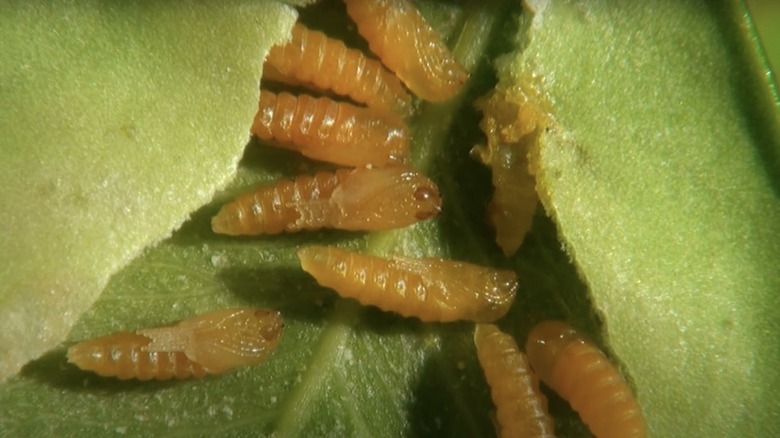An Entomology Expert Explains How To Identify And Control Boxwood Leafminer
While not harmful to humans, boxwood leafminers can certainly harm your ornamental shrubbery, making them an annoying pest for gardeners and homeowners. These larval pests feed exclusively on boxwood plants, which are commonly used for landscaping and ornamental purposes. Unfortunately, a severe infestation can damage and even kill your shrubs. In an exclusive interview with House Digest, Mosquito Squad entomologist Emma Grace Crumbley explained how to identify and prevent boxwood leafminer infestations.
According to Crumbley, the boxwood leafminers (Monarthropalpus sp.) that feed on boxwood plants are the larvae of adult leafminer flies, which look like tiny orange mosquitoes. "Instead of looking for hosts to feed on, these flies look for host plants," said Crumbley. "When the adult female finds a boxwood plant, she will insert close to 30 eggs in a single leaf. These eggs will hatch, and the larvae that emerge will feed on the boxwood leaves from the inside out. They act like tiny miners making tunnels and channels through the leaves."
Though Crumbley notes that, as an entomologist, she usually prefers to use scientific names when referring to insects, she makes a rare exception for leafminers. "Their name perfectly summarizes their behavior," she said.
How to identify boxwood leafminers and signs of infestation
Being able to identify leafminers throughout their lifespan and knowing the physical signs of an infestation can give you a better chance at preventing and controlling them. "Fortunately, boxwood leafminers only have one generation per year," Crumbley said exclusively to House Digest. "This means that once adult female flies lay their eggs, the eggs take the rest of the year to hatch and develop before emerging as adults and laying more eggs. We can use the natural history of these insects to predict the times of the year when infestation is most likely to occur."
Crumbley explains that adult flies mate and lay eggs within the leaves of boxwood plants in mid-spring. They then emerge and feast on your plants during the summer months. However, because the larvae are nearly microscopic, she notes that it's challenging to see them well enough to identify an infestation just by looking at the leaves. As such, they often go undetected, continuing to grow and feast on your plant's leaves from the inside before overwintering and pupating early the following spring.
According to Crumbley, the leafminers then escape the inside of the leaf after chewing and cutting through it, emerging as leafminer flies. Fortunately, Crumbley tells us that the leafminers turn dark during the pupae phase. Thus, they can often be identified by inspecting your plant's leaves — unlike their smaller, lighter larval counterparts.
How to control boxwood leafminers
Visible damage to your plants will be a clear indication of an infestation. According to Crumbley, your boxwood plants may begin to look like they have been damaged by the sun during the summer months. She adds that the leaves may turn brown and dry out or look blotchy and discolored. "As the infestation grows throughout the year, large bumps along the plant can be seen in addition to some circular tunneling," Crumbley said exclusively to House Digest.
If your plants become the site of a leafminer infestation, there are methods to control them, such as the use of a systemic insecticide. This gets absorbed by the plant and renders it toxic to the leafminers. "It's recommended that you treat for boxwood leafminers during the late-summer through fall period," Crumbley said. "This is the time when leafminers are actively eating, and systemic insecticides are the most effective at reaching the leafminer pests. Contact treatment for adults is less effective given their brief lifespan."
Crumbley adds that some preventive measures can quell a boxwood leafminer infestation without requiring the use of chemicals, such as regularly pruning your boxwood plants and cutting out visibly affected parts of the leaves. "This removal strategy is most effective during fall and winter when bumps or discoloring throughout leaves on the plant are most noticeable. If you do choose to manually remove leaves, however, be sure to bag up your cuttings and dispose of them away from other boxwood plants."


